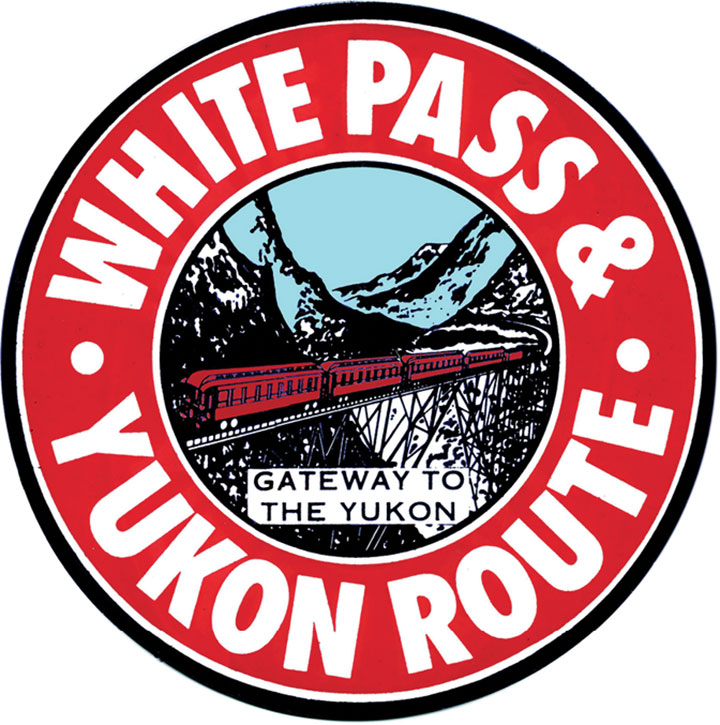The fabled White Pass & Yukon Route (WP&YR) was and is a narrow gauge railroad like no other in North America. Born out of the need to transport goods and materials north to support the Klondike Gold Rush, the railroad was overdue to the narrow gauge fad of the late nineteenth century. The isolation and the unique scenery have secured its continued existence well into the twenty-first century. In 1898 the railroad was young and the need for cheap locomotives was immediate. The White Pass acquired five used engines from the Columbia & Puget Sound Railroad in Washington between July and September. Several of these locomotives had a laundry list of previous owners with questionable maintenance histories. Their stories have been covered in detail in the first three articles of this series. None of these locomotives were particularly well suited for the steep grades, sharp curves, frigid cold, and generally wet conditions found in southeast Alaska. The White Pass placed an order in December 1898 with the Baldwin Locomotive Work of Philadelphia, PA for a pair of brand new engines built to handle the unique conditions of the line.
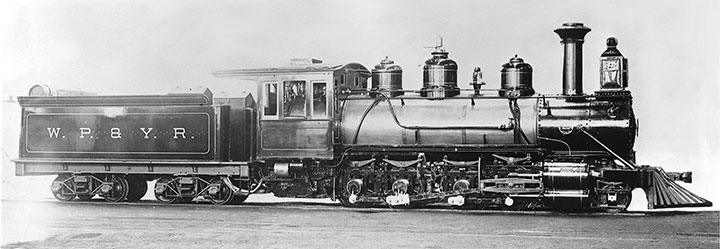
-Photo courtesy Railroad Museum of Pennsylvania (PHMC), negative #1147, Rob Bell collection.
The Baldwin Locomotive Works was the premiere steam locomotive manufacturer at the turn of the twentieth century. Baldwin had numerous patents and one of those was for the Vauclain compound steam locomotive, named after Samuel M. Vauclain who had in 1889 patented a way of using both low- and high-pressure steam to power a locomotive more efficiently. In 1896, Mr. Vauclain became a member of the Board of Directors at Baldwin. It was during this time that there seems to have been a push to sell Vauclain compound locomotives, with many large class 1 railroads buying them at the time. Baldwin built two Vauclain compound locomotives for the White Pass in January of 1899.
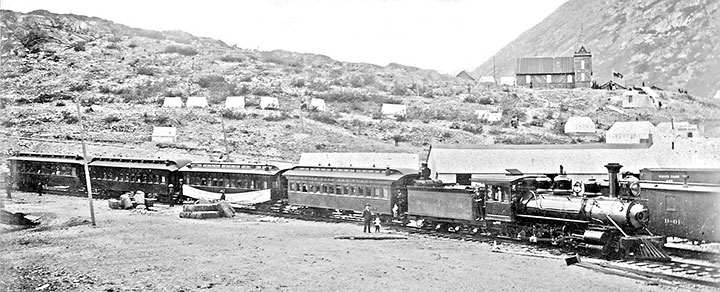
-Photo by H.C. Barley, Bruce Pryor collection.
The premise of the Vauclain compound was to use both a high-pressure piston and a low-pressure piston connected in parallel to a common crosshead driving the main rod of a steam locomotive. The low-pressure piston was roughly 66 percent larger than the high-pressure piston to equalize the forces being applied. Steam first entered the high-pressure cylinder and expanded, applying force, and moving the piston. This steam is then exhausted through a complex valve assembly into the low-pressure cylinder and used again. When starting a Vauclain compound, a manually operated starting valve applied high pressure steam into the low-pressure cylinder also. The system did not produce more power; rather it increased efficiency both in fuel and water usage. However, the added efficiency was offset by increased maintenance costs. The combination of the low- and high-pressure pistons invariably caused uneven wear on the crosshead, and the complex valve coupled with the starting valve added to the maintenance costs.
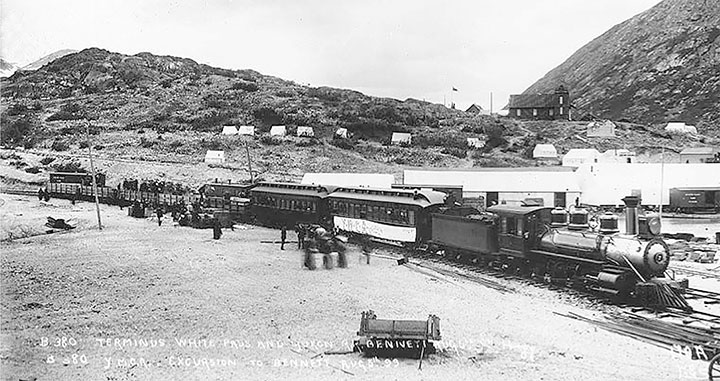
-Photo by E.A. Hegg, Bruce Pryor collection.
The two Vauclain compound locomotives built for the WP&YR were 2-8-0 consolidation types, numbered 6 and 7. They were construction numbers 16455 and 16456, respectively. The twins had 11½- x 20-inch high-pressure cylinders mounted below the 19- x 20-inch low-pressure cylinders. They had 38-inch diameter drivers and produced about 21,000 pounds of tractive effort which was quite an increase over any of the used engines the WP&YR had acquired. Both locomotives were put to work as soon as they arrived in Skagway in March 1899 bucking snow and hauling materials for the railroad’s construction. Number 6 pulled the first passenger cars to Bennett, British Columbia, in July of 1899—a train consisting of 4 coaches. Number 7 pulled a Y.M.C.A. excursion train to Bennett on August 5th, 1899, consisting of two coaches and five flatcars fitted with seats. The two Vauclain compound locomotives were renumbered 56 and 57 in 1900 and continued to labor together on the White Pass until 1906 when #57 was sold.
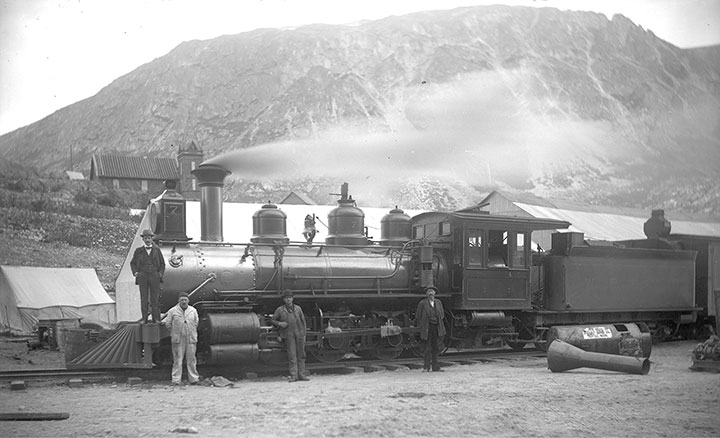
-Photo H.C. Barley, Dedman’s Photo Shop, Rob Bell collection.
The Klondike Mines Railway (KMR) at Dawson City, Yukon Territory (YT), bought #57 from the WP&YR in 1906 as KMR #3. The engine was loaded on a barge in Whitehorse, YT on either September 30th or October 1st and pushed over 300 miles north on the Yukon River by the steamer Bonanza King, arriving in Dawson City on October 4th. The KMR soon discovered a problem with the big number 3; it was much wider than either of their first two engines. The locomotive was a full nine feet wide across those massive compound cylinders and she couldn’t get past a couple of rock cuts. The road grade would need to be widened the next year when the line opened for that season. In the meantime, #3 would loan her tender to the KMR #2 due to its larger capacities of water and fuel.

-Photo H.C. Barley, Skagway Museum Townsend Collection-039, high resolution scan by Chuck Morse.
Between 1907 and 1910, KMR #3 saw very little use, if any, because the expected freight quantities did not materialize for the railway. It wasn’t until the 1910 season, when the line started hauling massive amounts of cordwood, that #3 started pulling her weight. Cordwood was being stockpiled for the steam thawing plants and the gold dredges. The KMR operated 24 hours a day during the 1912 and 1913 seasons. Yet, when the last trains pulled into Klondike City in late October of 1913 and all four of the KMR engines were parked in the engine house, it would be almost thirty-years before they would be disturbed. In 1925, the KMR and all its assets would come under control of the Yukon Consolidated Gold Corporation (YCGC). The United States Army bought #3’s tender in 1942 for use back on the White Pass & Yukon Route which the Army had leased during World War II. The Army assigned the tender to Rotary #2, and in 1949 the tender was placed in the Skagway River as riprap. It would be forty-eight years after KMR #3 had been parked in the engine house, that she would be donated to the Dawson City Museum by YCGC in 1961 and moved to Minto Park in Dawson City. By 1991, KMR #3 and two sister KMR locomotives were housed under a shelter and still reside there today.
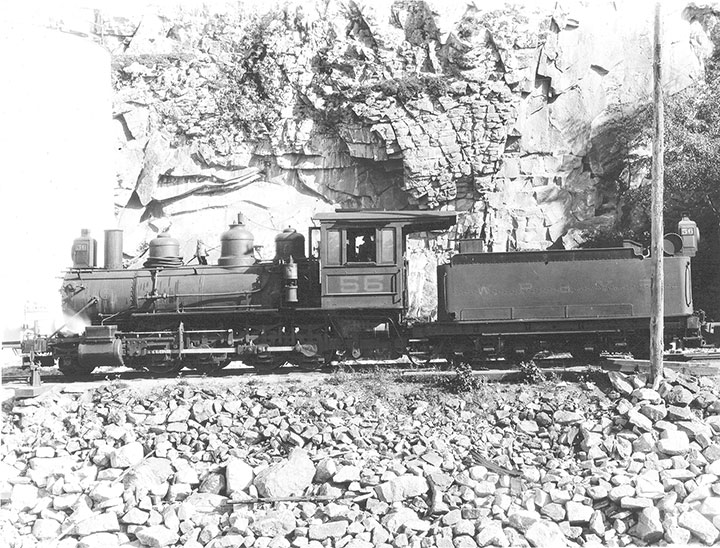
-Photo courtesy Railroad Museum of Pennsylvania (PHMC), negative #33677, Rob Bell collection.
A year after #57 was sold to the Klondike Mines Railway; the White Pass rebuilt the 56 from compound cylinders to “simple” with 17- x 20-inch cylinders in 1907. Photos showing footboards installed on the pilot indicate that #57 was used primarily as a switch engine by 1928. The locomotive was badly damaged in the 1932 Skagway roundhouse fire along with three other engines. Number 57 was rebuilt and put back to use, showing that WP&YR still had use for the locomotive. Her rebuilt cab had two cab side-windows instead of the original three. In 1936, the shop crew cut down #57’s tender into a slope-back style tender. Number 57 continued as the Skagway switcher until she was retired and scrapped in 1938, her tender was reassigned to another White Pass locomotive.
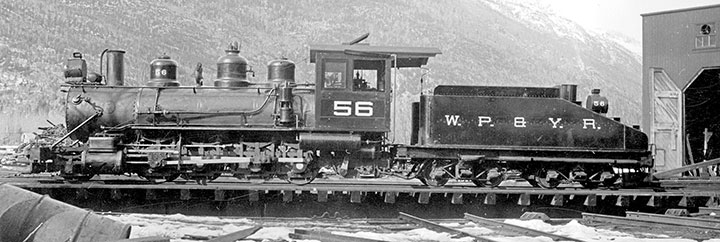
-Unknown photographer, Rob Bell collection.
The first new locomotives that the White Pass & Yukon Route bought were certainly successes on the lines where they served. The 6/56 and the 7/57 were a substantial improvement over any of the locomotives the railroad had acquired second hand. The 6/56 was rebuilt with simple cylinders and continued to serve the railroad for over thirty more years. While the 7/57 did not stay on the White Pass very long, she survives today as a unique example of a Vauclain compound locomotive in the Yukon Territory.
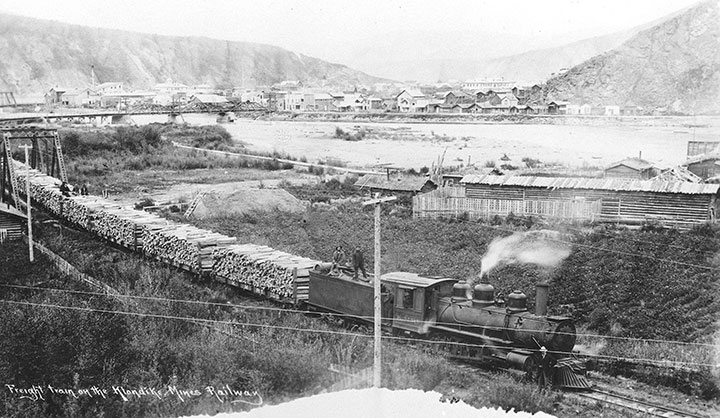
-Photo by E.O. Ellingsen, scanned from the National Archives of Canada, negative C4887, courtesy Eric L. Johnson.
As always, I would like to acknowledge the contributions of Boerries Burkhardt, David Fletcher, Robert Hilton, Eric L. Johnson, Chuck Morse, Bruce Pryor, and John Stutz. Without their assistance and generosity of information and photos, these articles would not be possible. In the next issue I will examine a truly unique locomotive from the White Pass fleet accompanied by another of David Fletcher’s drawings.
